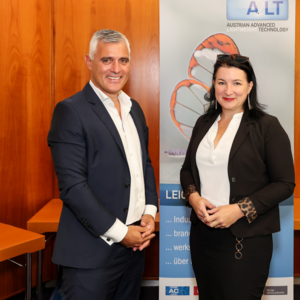Lightweight construction is a key technology for sustainability
Thanks to lightweight construction, cars and planes use less fuel, wind turbines become more powerful and construction becomes more resource-efficient. Viewed over the life cycle of products, lightweight construction leads to a significant reduction in CO2 emissions and thus supports the achievement of national and international sustainability goals. The 21 members of A2LT are committed to affordable, sustainable and intelligent lightweight solutions across all sectors and materials.
The increasing material and energy prices of the past few years clearly show how important lightweight construction expertise is for the resilience of industry locations. This also applies apart from mobility applications, which are drivers of innovation but are by far not the only area of application for lightweight construction. Using as little primary material as possible has the greatest potential in terms of CO2 savings – this is how lightweight construction is also relevant in sectors such as logistics. High-bay warehouses made of high-strength steel use less material and thus save enormous amounts of energy and costs. There are many such examples, but the basic idea is always the same: Intelligent, affordable, sustainable lightweight construction is possible and brings tangible savings if it is thought through from the start.
The demand for lightweight construction technology is therefore constantly increasing – at the same time the requirements for domestic companies and research institutions, which are sought-after partners worldwide thanks to their know-how. As a high-tech location, Austria has the chance to be an international pioneer. A great strength is that all competences are available in Austria, both in research and in the industry: all materials such as metal, plastic, composite material, wood as well as the production technology. As a positive result, distances are short.
Examples of material and technology know-how
„FACC has been researching the development of new lightweight construction methods intensively for years – we focus in particular on the development of new materials and processes. The focus is not only on ensuring that the end product is as light as possible, but also on considering the product life cycle. Among other things, this means that less energy is used during production and good recyclability at the end of the cycle. We have succeeded in developing an ultra-light material that is based on a resin from sugar cane and in which aviation is already showing great interest," explains FACC CEO Robert Machtlinger. "As one of the technology leaders, we rely on close cooperation with research institutions and OEMs in order to further expand this lead in the future."
High-strength steels, aluminum, composite material – less weight means less energy consumption. However, it is not so obvious that there is also enormous potential for lightweight construction in the material structure. New manufacturing processes such as 3D printing can be used, for example, to build bionic structures which are just as stable with less weight – regardless of the material.
An example of this comes from Pankl: Motorsport fans know the "HALO" bar in the cockpit, which protects racing drivers from flying debris. For the IndyCar racing series, Pankl builds the titanium frame for the protective screen using the 3D printing process.
„This is a classic example of applied lightweight construction. A so-called additive manufacturing process enables high flexibility, fast implementation and low weight," explains Pankl CTO and A2LT platform spokesman Stefan Seidel.
Pankl operates its own competence center for additive manufacturing together with several partners.
Material mix for e-mobility
E-mobility shows how far lightweight construction can go and replace conventional ways of thinking. It is currently still the case that electric cars weigh significantly more than comparable combustion engines. But weight is an essential criterion for the efficiency and range of the vehicles. The members of A2LT are already researching and developing for these future solutions. One example is the battery box as the central element of e-vehicles. There, different lightweight construction solutions in a multi-material mix come into question: steel-based, cast aluminum or composite materials.
One example from voestalpine is the flextric battery box module system: It combines the properties of stability/safety and optimized weight. voestalpine draws on its extensive know-how in handling steel and shows what lightweight construction is all about: firstly, the material used is high-strength steel, secondly, the design is chosen in such a way that the structure of the battery boxes saves weight – in total up to 30 percent.
Double benefit for climate and economic power
A main argument for lightweight construction is the saving of energy and raw materials – both in the manufacture of the product and in its usage. This is of the utmost importance in view of the current CO2 and climate debate. A2LT strives to give strong support to the European Union's Green Deal and bring this contribution to the attention of policymakers.
Against the background of dwindling resources and at the same time a worldwide growing desire for mobility, prosperity and comfort, lightweight construction is more important than ever and promises more jobs and enormous added value. The study „The economic importance of lightweight construction" (link zur relavnten Ebene einfügen) not only makes the economic dimension of lightweight construction transparent for the first time. As a pilot project, it is also important preparatory work for a Europe-wide harmonized model to make lightweight construction visible as an economic factor.
There is hardly any other technology with a comparable leverage effect: lightweight construction enables resource-saving products and at the same time has demonstrable effects on the economy, as the study has shown.
Thought through
In line with circular economy, efforts in lightweight construction are moving in the direction of "design for recycling". The trend is towards an overall ecological view of technologies – i.e. from the production of the materials, the product itself and the ecological footprint during operation to recyclability. In an overall view, lightweight construction is therefore a key technology for achieving sustainability.
In the European project DeremCo (De&Remanufacturing for Circular Economy Investments in the Composite Industry), A2LT is actively involved in the recycling and end-of-life solutions of fiber-reinforced plastics

Talking Heads with Stefan Seidel und Anna Kleissner
Materials and energy are scarce. Climate protection is the need of the hour. At the same time, the economy should be stable and grow – also to secure existing jobs and create new ones.
What if we could address all of these challenges simultaneously? It's possible! With the key technology of lightweight construction. Florian Danmayr talks to economist Anna Kleissner, who has conducted a remarkable study on behalf of the Lightweight Construction Platform A2LT, and Stefan Seidel, CTO at Pankl Racing Systems and spokesperson for A2LT.
